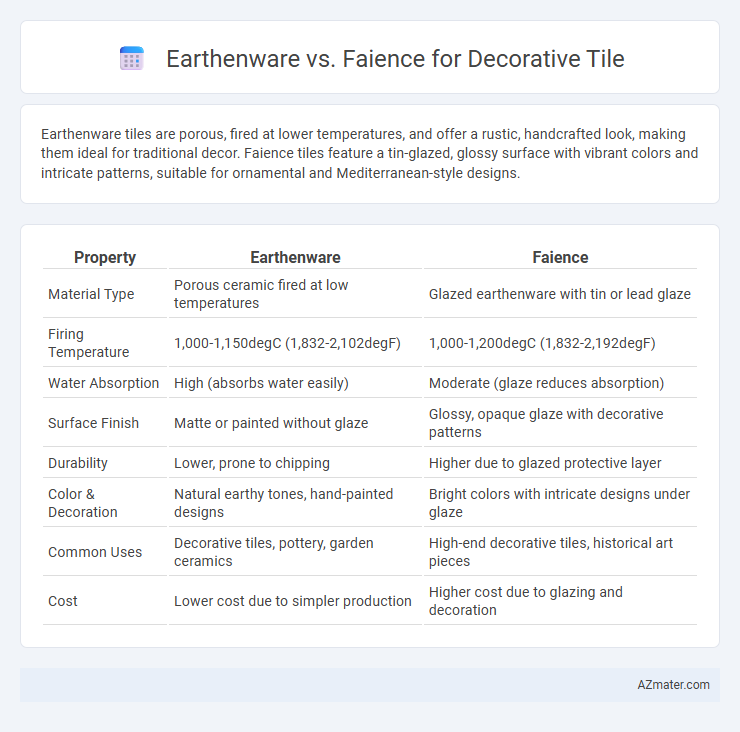Earthenware tiles are porous, fired at lower temperatures, and offer a rustic, handcrafted look, making them ideal for traditional decor. Faience tiles feature a tin-glazed, glossy surface with vibrant colors and intricate patterns, suitable for ornamental and Mediterranean-style designs.
Table of Comparison
| Property | Earthenware | Faience |
|---|---|---|
| Material Type | Porous ceramic fired at low temperatures | Glazed earthenware with tin or lead glaze |
| Firing Temperature | 1,000-1,150degC (1,832-2,102degF) | 1,000-1,200degC (1,832-2,192degF) |
| Water Absorption | High (absorbs water easily) | Moderate (glaze reduces absorption) |
| Surface Finish | Matte or painted without glaze | Glossy, opaque glaze with decorative patterns |
| Durability | Lower, prone to chipping | Higher due to glazed protective layer |
| Color & Decoration | Natural earthy tones, hand-painted designs | Bright colors with intricate designs under glaze |
| Common Uses | Decorative tiles, pottery, garden ceramics | High-end decorative tiles, historical art pieces |
| Cost | Lower cost due to simpler production | Higher cost due to glazing and decoration |
Understanding Earthenware and Faience
Earthenware is a porous ceramic fired at lower temperatures, characterized by its clay body and often coated with a glaze to enhance durability and color vibrancy. Faience, a type of tin-glazed earthenware, features an opaque white glaze that provides a smooth surface ideal for intricate painted designs and vivid patterns. Understanding the differences in their firing processes, composition, and glazing techniques highlights why faience offers a more refined decorative finish compared to standard earthenware tiles.
Historical Origins of Earthenware and Faience
Earthenware, dating back to ancient Mesopotamia around 4500 BCE, is one of the earliest forms of pottery made from natural clay, fired at lower temperatures, resulting in a porous and durable material ideal for functional and decorative tiles. Faience, originating from ancient Egypt circa 4000 BCE, is a glazed non-clay ceramic known for its vibrant blue-green hues achieved through a silica-based surface coating, often used in decorative tiles for symbolic and ornamental purposes. Both materials played significant roles in historical architecture, with earthenware offering versatile applications and faience providing distinctive aesthetic qualities in tile design.
Key Material Differences
Earthenware tiles are made from porous clay fired at lower temperatures, resulting in a softer, more absorbent material that requires a glaze to enhance durability and water resistance. Faience tiles consist of a fine, white clay body coated with a tin-based opaque glaze, creating a highly decorative, glossy finish ideal for intricate patterns and vibrant colors. The primary material difference lies in faience's glaze composition and firing technique, which produce a harder, less porous surface compared to the more rustic and porous nature of earthenware.
Comparative Aesthetic Qualities
Earthenware tiles offer a rustic, matte finish with rich, earthy tones that evoke a traditional and handcrafted appearance, making them ideal for warm, natural decor styles. Faience tiles, known for their glossy, brightly colored glaze, provide a vibrant and polished look that enhances intricate patterns and adds a luxurious Mediterranean flair. The choice between earthenware and faience hinges on desired aesthetic effects: earthenware's subdued texture versus faience's luminous surface.
Durability and Longevity Factors
Earthenware tiles typically exhibit lower durability and porosity, making them more susceptible to chipping and water damage compared to faience tiles. Faience, a type of glazed earthenware, offers enhanced longevity due to its non-porous, vitreous surface that resists stains, moisture, and wear over time. For decorative applications in high-traffic or moisture-prone areas, faience tiles provide superior performance and longer-lasting beauty relative to traditional earthenware.
Suitability for Indoor vs. Outdoor Use
Earthenware tiles, characterized by their porous nature and lower firing temperatures, are best suited for indoor decorative applications where moisture exposure is minimal to prevent cracking and deterioration. Faience tiles, being glazed and fired at higher temperatures, offer enhanced durability and moisture resistance, making them more appropriate for outdoor use or areas with higher humidity. The choice between earthenware and faience depends on environmental exposure, with faience providing superior weather resistance and longevity for exterior installations.
Design Versatility and Artistic Styles
Earthenware offers exceptional design versatility with its porous surface allowing rich, absorbent glazes that enhance intricate patterns and vibrant colors, making it ideal for rustic, traditional, and folk art styles. Faience, a type of tin-glazed earthenware, provides a glossy, opaque white surface perfect for detailed, colorful motifs often seen in Mediterranean and Islamic decorative arts. Both materials enable diverse artistic expressions, but faience's smooth finish supports finer brushwork and intricate designs, while earthenware's natural texture lends itself to more tactile, organic aesthetics.
Maintenance and Cleaning Requirements
Earthenware tiles require regular sealing to prevent moisture absorption and staining, making maintenance more frequent compared to faience tiles. Faience tiles feature a glassy, vitreous glaze that resists water and dirt, allowing for easier cleaning with mild detergents and reducing the risk of damage. Both materials benefit from avoiding abrasive cleaners, but faience's durable glaze typically demands less intensive upkeep over time.
Cost Comparison: Earthenware vs Faience
Earthenware tiles typically cost less than faience due to their simpler production process and lower material quality. Faience tiles, known for their intricate glazing and higher durability, command higher prices reflecting skilled craftsmanship and superior finishes. Budget-conscious projects often favor earthenware for affordability, while decorative installations prioritize faience's aesthetic value despite greater expense.
Choosing the Right Tile for Your Space
Earthenware tiles offer durability and a rustic charm with their porous surface, making them ideal for low-traffic indoor spaces prone to moisture but not heavy wear. Faience tiles, known for their glossy, glass-like finish created through a tin-glaze technique, provide vibrant colors and intricate patterns perfect for decorative accents in kitchens, bathrooms, or feature walls. Choosing between earthenware and faience depends on balancing the need for durability against aesthetic appeal and location-specific moisture exposure in your space.

Infographic: Earthenware vs Faience for Decorative Tile
 azmater.com
azmater.com